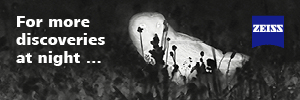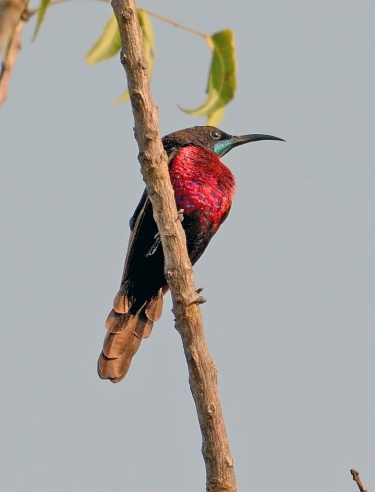- Chalcomitra senegalensis
Nectarinia senegalensis
Identification
Length 13-15 cm (5-6 in), mass 12-15 g, males larger than females
Male: Black with iridescent emerald-green crown and chin and scarlet throat and upper breast. Bill, legs and feet black, eyes dark brown.
Female: Upper parts and face dark brown, eyebrow whitish. Chin and throat dark brown, feathers edged light brown. Breast and belly pale yellow, streaked dark brown.
Distribution

Photo © by Kiki
Kruger National Park, South Africa, November 2005
Sub-Saharan Africa:
Western Africa: Mauritania, Senegal, The Gambia, Guinea-Bissau, Guinea, Mali, Sierra Leone, Liberia, Ivory Coast, Burkina Faso, Ghana, Togo, Benin, Nigeria, Niger, Niger, Chad, Cameroon, Central African Republic, Equatorial Guinea, Democratic Republic of Congo, Angola
Eastern Africa: Sudan, South Sudan, Eritrea, Ethiopia, Kenya, Uganda, Rwanda, Burundi, Tanzania, Mozambique, Malawi
Southern Africa: Namibia, Botswana, Zimbabwe, South Africa, KwaZulu-Natal and eSwatini
Taxonomy
This is one of the seven Sunbirds that have recently been moved into the genus Chalcomitra from the genus Nectarinia.
Subspecies
Chalcomitra senegalensis has 5 subspecies, variation being mostly in the colour of the underparts[1]:
- C. s. senegalensis:
- C. s. acik:
- Northern Cameroon to Central African Republic, southwestern Sudan, western and central South Sudan, northeastern Democratic Republic of the Congo, and northwestern Uganda
- C. s. proteus:
- Southeastern Sudan, southeastern South Sudan (Boma Hills), Eritrea, and Ethiopia
- C. s. lamperti:
- Eastern Democratic Republic of the Congo, southern South Sudan (Imatong Mountains, Leboni Forest), Rwanda, Burundi, Uganda (except northwest), southwestern Kenya, and Tanzania
- C. s. gutturalis:
- South East Kenya to Angola, western Zambia, western Democratic Republic of the Congo, northern Botswana, eastern South Africa
Habitat
Broadleaved open woodland, moist thornveld, coastal bush, parks and gardens.
Behaviour
Diet
Often in groups at nectar sources where males frequently chase conspecifics and other Sunbirds. Also hunts insects and spiders, but usually alone. May hover to feed, but usually perches.
Breeding
The male defends the the breeding territory. The nest is pear-shaped with a hood over the entrance hole, and suspended from a branch. It is built by the female using dry grass, stems, leaves and/or bark bound by spider web. Usually two eggs are laid and incubated by the female. Chicks and fledglings are fed by both parents for up to eight weeks. Parasitised by Klaas's Cuckoo and, less often, African Emerald Cuckoo and Dideric Cuckoo
Gallery
Click on photo for larger image
Juvenile, female, Subspecies gutturalis
Photo © by Alan Manson
Ngwenya, adjascent to Kruger National Park, South Africa, September 2007Juvenile, male, Subspecies gutturalis
Photo © by volker sthamer
Hawassa, Ethiopia, February 2017
References
- Clements, J. F., T. S. Schulenberg, M. J. Iliff, S. M. Billerman, T. A. Fredericks, B. L. Sullivan, and C. L. Wood. 2019. The eBird/Clements Checklist of Birds of the World: v2019. Downloaded from http://www.birds.cornell.edu/clementschecklist/download/
- Avibase
- Handbook of the Birds of the World Alive (retrieved December 2016)
- Hockey, PAR, WRJ Dean, and PG Ryan, eds. 2005. Roberts' Birds of Southern Africa. 7th ed. Cape Town: John Voelcker Bird Book Fund. ISBN 978-0620340533
Recommended Citation
- BirdForum Opus contributors. (2024) Scarlet-chested Sunbird. In: BirdForum, the forum for wild birds and birding. Retrieved 29 April 2024 from https://www.birdforum.net/opus/Scarlet-chested_Sunbird
External Links
Search the Gallery using the scientific name:
Search the Gallery using the common name:
GSearch checked for 2020 platform.








